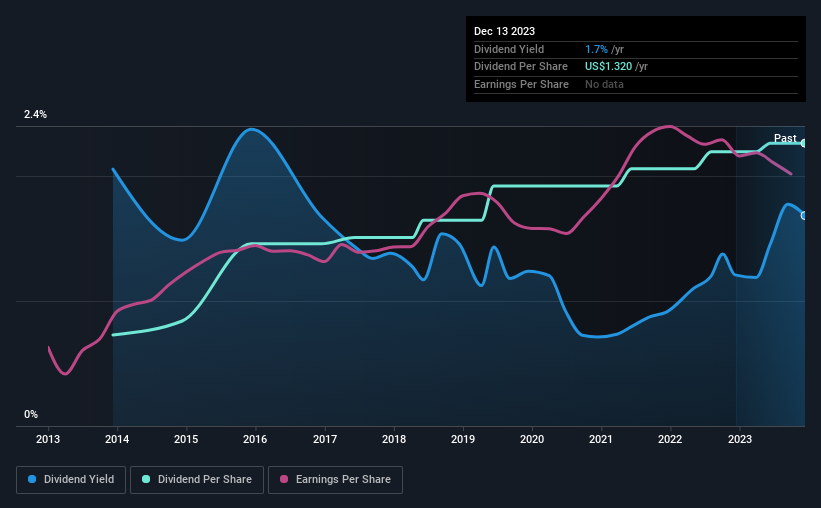Omega Flex, Inc. (NASDAQ:OFLX) Is About To Go Ex-Dividend, And It Pays A 1.7% Yield
It looks like Omega Flex, Inc. (NASDAQ:OFLX) is about to go ex-dividend in the next four days. The ex-dividend date is one business day before a company's record date, which is the date on which the company determines which shareholders are entitled to receive a dividend. The ex-dividend date is important because any transaction on a stock needs to have been settled before the record date in order to be eligible for a dividend. Therefore, if you purchase Omega Flex's shares on or after the 18th of December, you won't be eligible to receive the dividend, when it is paid on the 4th of January.
The company's next dividend payment will be US$0.33 per share, on the back of last year when the company paid a total of US$1.32 to shareholders. Based on the last year's worth of payments, Omega Flex has a trailing yield of 1.7% on the current stock price of $78.41. If you buy this business for its dividend, you should have an idea of whether Omega Flex's dividend is reliable and sustainable. So we need to check whether the dividend payments are covered, and if earnings are growing.
Check out our latest analysis for Omega Flex
If a company pays out more in dividends than it earned, then the dividend might become unsustainable - hardly an ideal situation. Omega Flex paid out more than half (59%) of its earnings last year, which is a regular payout ratio for most companies. Yet cash flows are even more important than profits for assessing a dividend, so we need to see if the company generated enough cash to pay its distribution. Dividends consumed 63% of the company's free cash flow last year, which is within a normal range for most dividend-paying organisations.
It's encouraging to see that the dividend is covered by both profit and cash flow. This generally suggests the dividend is sustainable, as long as earnings don't drop precipitously.
Click here to see how much of its profit Omega Flex paid out over the last 12 months.
Have Earnings And Dividends Been Growing?
Companies with consistently growing earnings per share generally make the best dividend stocks, as they usually find it easier to grow dividends per share. If earnings fall far enough, the company could be forced to cut its dividend. With that in mind, we're encouraged by the steady growth at Omega Flex, with earnings per share up 7.1% on average over the last five years. Decent historical earnings per share growth suggests Omega Flex has been effectively growing value for shareholders. However, it's now paying out more than half its earnings as dividends. If management lifts the payout ratio further, we'd take this as a tacit signal that the company's growth prospects are slowing.
Another key way to measure a company's dividend prospects is by measuring its historical rate of dividend growth. In the last 10 years, Omega Flex has lifted its dividend by approximately 12% a year on average. It's encouraging to see the company lifting dividends while earnings are growing, suggesting at least some corporate interest in rewarding shareholders.
To Sum It Up
Is Omega Flex worth buying for its dividend? Earnings per share have been growing modestly and Omega Flex paid out a bit over half of its earnings and free cash flow last year. In summary, it's hard to get excited about Omega Flex from a dividend perspective.
Want to learn more about Omega Flex? Here's a visualisation of its historical rate of revenue and earnings growth.
A common investing mistake is buying the first interesting stock you see. Here you can find a full list of high-yield dividend stocks.
Have feedback on this article? Concerned about the content? Get in touch with us directly. Alternatively, email editorial-team (at) simplywallst.com.
This article by Simply Wall St is general in nature. We provide commentary based on historical data and analyst forecasts only using an unbiased methodology and our articles are not intended to be financial advice. It does not constitute a recommendation to buy or sell any stock, and does not take account of your objectives, or your financial situation. We aim to bring you long-term focused analysis driven by fundamental data. Note that our analysis may not factor in the latest price-sensitive company announcements or qualitative material. Simply Wall St has no position in any stocks mentioned.

